|
Related FAQs: Fungiids, Fungiid
Corals 2, Fungiid
Identification, Fungiid
Behavior, Fungiid
Compatibility, Fungiid
Selection, Fungiid Systems,
Fungiid Feeding, Fungiid Disease, Fungiid Reproduction, Stony/True Coral, Coral System Set-Up, Coral System Lighting, Stony Coral Identification, Stony Coral Selection, Coral Placement, Foods/Feeding/Nutrition, Disease/Health, Propagation, Growing Reef Corals, Stony Coral Behavior,
Related Articles:
The Mushroom, Disc or Plate
Corals, Family Fungiidae
by Bob Fenner,
Large Polyp Stony
Corals, Stony or True Corals,
Order Scleractinia, Dyed
Corals,
/The Best Livestock For Your Reef Aquarium:
Plate Corals, Family Fungiidae, Pt.
1
To: Part 2,
Pt. 3
|
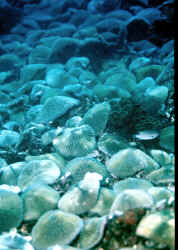
|
|
By Bob Fenner
|
Fungiid field, Malaysia
|
<To Do: Images, short desc. like WA Coral quide for family>
Family Fungiidae Dana 1848. The Mushroom Corals could be
poster children for LPS (Large Polyped Stony Corals) if they
weren't so odd in many ways. These are solitary, non-reef building
animals that amongst the true or stony corals are ambulatory... yes,
they're capable of movement. All but three genera remain free,
unattached from the substrate as adults.
Structurally, the Fungiids are unified as being
solitary, circular to oblong in shape with septo-costae radiating from
their upper surface center, and costae from flattened underneath
sides.
Bigger PIX:
The images in this table are linked
to large (desktop size) copies. Click on "framed" images
to go to the larger size. |
|
%20MD.JPG)
%20MD.JPG)
|
Aquarium Care Note:
Most Fungiids are found in shallow water (under
ten meters in depth) on various types of substrates; rocky, sandy, to
silty. Ones with a high relief (dome-shaped), and spines/septa of low
relief utilize these aspects of their morphology, expansion of their
polyp-bodies, and/or muco-ciliary action. The more flat-profile,
un-toothed septa species that are more often offered to the hobby
don't have as much latitude at throwing off sediment and should be
placed accordingly on softer, low-detritus bottoms out of the way of
direct current.
| Though these mobile
Scleractinians don't sting each other, other sessile
invertebrates must be placed, arranged out of harm's way,
including climbing harm's way. Most other corals will suffer
given contact with a Fungiid skeleton, polyp or its mucus. At right
a sick, mis-placed Fungiid... miserable. |
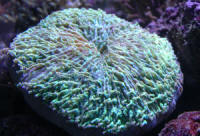
|
Take care in moving the Plate Corals. They tear
easily. Wafting your hand gently near an expanded one will cause it to
retreat into its chitinous/calcareous skeleton. Touch it on the
bottom/underside and slip it into a water filled bag
underwater.
Fungiids bear endosymbiotic algae that require
strong light, but all benefit from regular feeding as well. Foods may
be placed on their upper surfaces or a mash of appropriate size matter
can be basted in their direction... with the filter pumps temporarily
cycled off.
As a general rule all Fungiids with the
exception of Heliofungia actiniformis (which IMO should be removed from
this family... taxonomically) are pretty sturdy aquarium species...
given initial good health, suitable, established homes... Helio/Long
tentacle plate corals rarely fare well for any length of time...
especially if not placed on soft/fine sand substrates.
|
Reproduction: Reproduction can be sexual but is
often encountered in the form of asexually produced daughter
colonies, called anthocauli. These asexual bits grow and break
off a parent, making their lives on the bottom separately.
Fragmentation is another way Fungiids may be reproduced. This
requires at most the breaking of a donor into six pieces.
Acanthocauli attached on a rock in captivity.
|
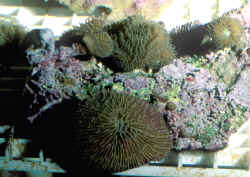
|
|
Identification Notes: There are some 40 plus species in
eleven genera that make up the Fungiid family... they are
described and discerned out in the field and lab mainly by their
hard skeletal make-up. Septa/e are radiating ridges on their
upper sides, costa/e in-between... the shape, number, regularity
of the "teeth" on these structures are species
identifying characteristic.
|

|
Genus Cantharellus Hoeksema & Best 1984. Solitary or colonial, bodies
are cup shaped with wavy margins. Species are small (65-70 mm. across) in the W.
Pac. ranges, 'cept for Red Sea where they may attain 20 cm.!
Genus Ctenactis Verrill 1864. Elongated polyps with round ends, a central
furrow of one to many enclosed mouths. Septa are regularly arrayed with
large triangular teeth.
| Ctenactis crassa (Dana 1846). Axial furrow
extends apparently to both ends of the polyp. Multiple mouths, all
within the furrow. An older polyp in the Red Sea. |

|
| Ctenactis echinata (Pallas 1776). Both
septa and costal (top and bottom skeletal lines) bear teeth. One
mouth. Below, juvenile polyp, adult and close-up in
Fiji. |
Genus Cycloseris Mile Edwards & Haime 1849. Usually under two
inches in diameter, with flat to dome-shaped circular skeletons, a
central mouth, fine teeth on their costal and septal free edges (vs. denticular/spiny
on the costae of the similar genus Fungia). No pits on
undersides. No perforations in the body as exists in Fungia spp. Generally not found on reefs. Indo-Mid Pacific; Red
Sea, East Africa to Australia, Indonesia, Marquesas.
| Cycloseris sp. skeleton in the Red Sea, top
view. This genus is distinguished from Fungia by its
finely serrated costal edges (vs. denticular in Fungia), and
lack of perforations of said walls. Hold the skeleton up to a bright
light... |

|
Bigger PIX:
The images in this table are
linked to large (desktop size) copies. Click on "framed"
images to go to the larger size. |
 |
| Cycloseris cyclolites (Lamarck 1801).
Circular polyps of up to 40 mm. diameter, concave underneath. Septa
are thick, straight, thicker and exsert near the mouth. Pale to
cream in color usually, but may be brightly colored in shallow
water. N. Sulawesi pic. |

|
| Fungia (Cycloseris)
costulata. This species is distinguished by its straight,
non-wavy septal walls and that they decidedly thicken toward
the mouth/center. Occur in sand, mud. West Pacific. N.
Sulawesi pix. |
%20costulata%20NSUL%20MD.JPG) |
| Cycloseris tenuis
(Dana 1846), Thin flat polyps. Uniform septa, but in obvious
different orders, thick irregular costae underneath. N. Sulawesi
pic. |

|
| Cycloseris vaughani Boschma 1923, Vaughan's Razor Coral. Circular in shape, flat on
the bottom. Found on hard surfaces in shallow depths (to forty feet
or so). Six prominent septal ribs. Big Island pic. |
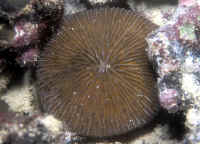
|
Genus Danafungia Wells 1966. Circular bodied (corolla), very
large septal teeth.
Genus Diaseris Milne Edwards & Haime 1849. Solitary, flat
corals that have their mouth situated at the top where fan-shaped body
segments join together. Thick septa with blunt teeth, resemble
granules.
Bigger PIX:
The images in this table are
linked to large (desktop size) copies. Click on "framed"
images to go to the larger size. |
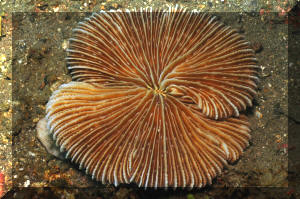 |
| Diaseris distorta (Michelin 1843). Skeletons
made up of fan-shaped elements of up to 40 mm in diameter. Often
with living polyp swollen to a few times the skeleton volume. N.
Sulawesi pix. |
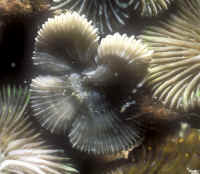 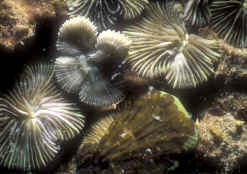
|
Genus Fungia Lamarck 1801, Disk, Tongue, Mushroom Corals.
Thirty three species that are difficult to discern. Circular, oval to oblong,
flat to dome-shaped. Single polyp, single mouth in the center. Costae
as rows of spines, septa with smaller pointed teeth. Pits in the skeleton
underside between costae. Have rows of short tentacles that are widely
spaced. Excellent aquarium subjects.
|
To Do: Chart for discerning species: Characteristics
vs. species: Circular or irregular polyp shape, dome shape in
center?, size of costae, holes between costae (on undersides),
Septal teeth shape, septae shape/regularity, tentacular lobes
present? color, distribution... Important to include
close-ups of above and obverse sides (ex. at right).
|
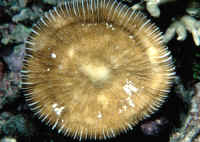
|
Fungia granulosa Klunzinger 1879
/COTW:
Characters: Polyps
are circular, up to 135 millimetres diameter and flat or with a central
arch. Septa are thick and wavy, with finely granulated margins.
Tentacular lobes are wide, causing the wavy shape of the septa. Costae
are fine. The undersurface has pits between the costae.
Colour: Usually
brown.
Similar
Species: Fungia
scabra. See also Cycloseris
costulata.
Habitat: Reef
slopes and lagoons.
Abundance: Usually
uncommon.
Here off Hawai'i's Big Island at
night. |

|
| Fungia corona Doderlein 1901. Polyps flat to
convex with irregular outline. Septa of different sizes with large
teeth. Raja Ampat 08. |
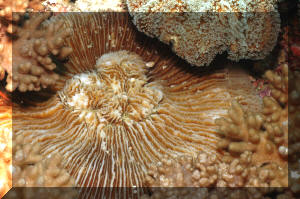
|
| Fungia danai Milne Edwards & Haime 1851.
Circular polyps of up to twelve inches in diameter, with definitive
raised central area (arch). Septa are straight, have large teeth
and prominent tentacular lobes. A common species in the wild and
trade. Fiji images. |
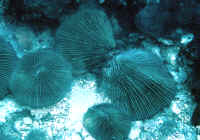
|
Bigger PIX:
The images in this table are linked
to large (desktop size) copies. Click on "framed" images
to go to the larger size. |
|
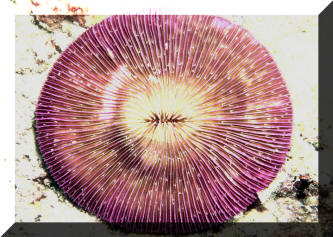
|
| Fungia fralinae Nemenzo 1955. Circular
flattened polyps. Septa of two intermittent kinds; taller and
lower, both with fine teeth, both thin and straight. Tentacles
generally evident during the day have colored tips. Light greenish
brown in color overall. Bunaken, Sulawesi, Indonesia
photo. |
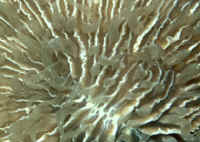
|
Bigger PIX:
The images in this table are linked
to large (desktop size) copies. Click on "framed" images
to go to the larger size. |
|

|
Fungia or Heliofungia fralinae
Gittenberger, Reijnen and Hoeksema (2011) /COTW:
Characters: Polyps
are circular. Septa are in two distinct orders, those of the first order
being very exsert, straight and thin. All septa have fine teeth.
Tentacles, which are sometimes bifurcated, are commonly extended during
the day.
Colour: Usually
olive-green with tiny but conspicuous violet tentacle tips.
Similar
Species: The exsert alternating septa with fine
teeth are distinctive.
Habitat: Reef
slopes and lagoons.
Abundance: Uncommon.
Taxonomic Note: Called Heliofungia
fralinae by Gittenberger,
Reijnen and Hoeksema (2011) from molecular data, but
this species has little in common with Heliofungia
actiniformis. Heliofungia is
distinctively monospecific. Juv.s here in N. Sulawesi, Indo.
|
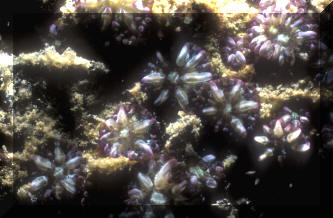
|
| Fungia fungites (Linnaeus 1758). Polyps
irregularly circular to round in appearance. Regular, saw like,
triangular septal teeth. Often with tentacular lobes
showing. Aquarium and Pulau Redang, Malaysia photos. |
 |
Bigger PIX:
The images in this table are linked
to large (desktop size) copies. Click on "framed" images
to go to the larger size. |
|

|
| Fungia klunzingeri Doderlein 1901. Circular
polyps of up to eight inches diameter, flat or with a central dome
area. Septa of different sizes with large triangular teeth in
patterns. Common in the Red Sea where these images were
made. |
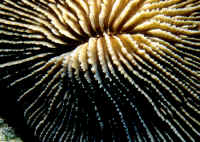
|
Bigger PIX:
The images in this table are linked
to large (desktop size) copies. Click on "framed" images
to go to the larger size. |
|
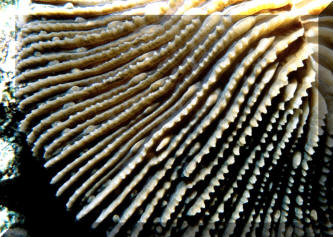
|
| Fungia moluccensis Horst 1919. Here in S. Leyte 2013 |
%20MD.JPG)
|
| Fungia scruposa Klunzinger 1879. Oval, circular
polyps to 240 cm. across. Shallow sloping from center (not highly arched);
septa wavy, tightly packed. Costae (outside the mouth area ridges) are
irregularly toothed with simple/r spines. Numerous holes on underside twixt
costae. Red Sea 2019. |
%20MD.JPG)
|
Bigger PIX:
The images in this table are linked
to large (desktop size) copies. Click on "framed" images
to go to the larger size. |
|
%20MD.JPG)
|
| Fungia scutaria Lamarck 1801. Oval, heavy
polyps with high, regularly placed and often colored tentacular lobes. To seven
inches. Indo-Pacific. Occur in many colors. At right in
Hawai'i. Below: Specimens in the Red Seas upper Gulf of Aqaba,
and one in the Maldives to show the degree of arching
possible. |
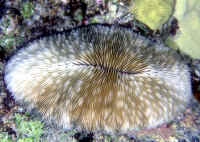 
|
Bigger PIX:
The images in this table are linked
to large (desktop size) copies. Click on "framed" images
to go to the larger size. |
|
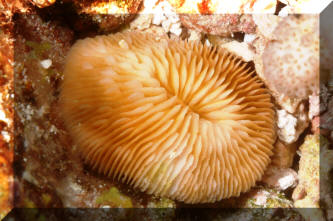
|
Link to: Fungia species: Bigger PIX:To: Pt.
2, Pt.
3
|
|

